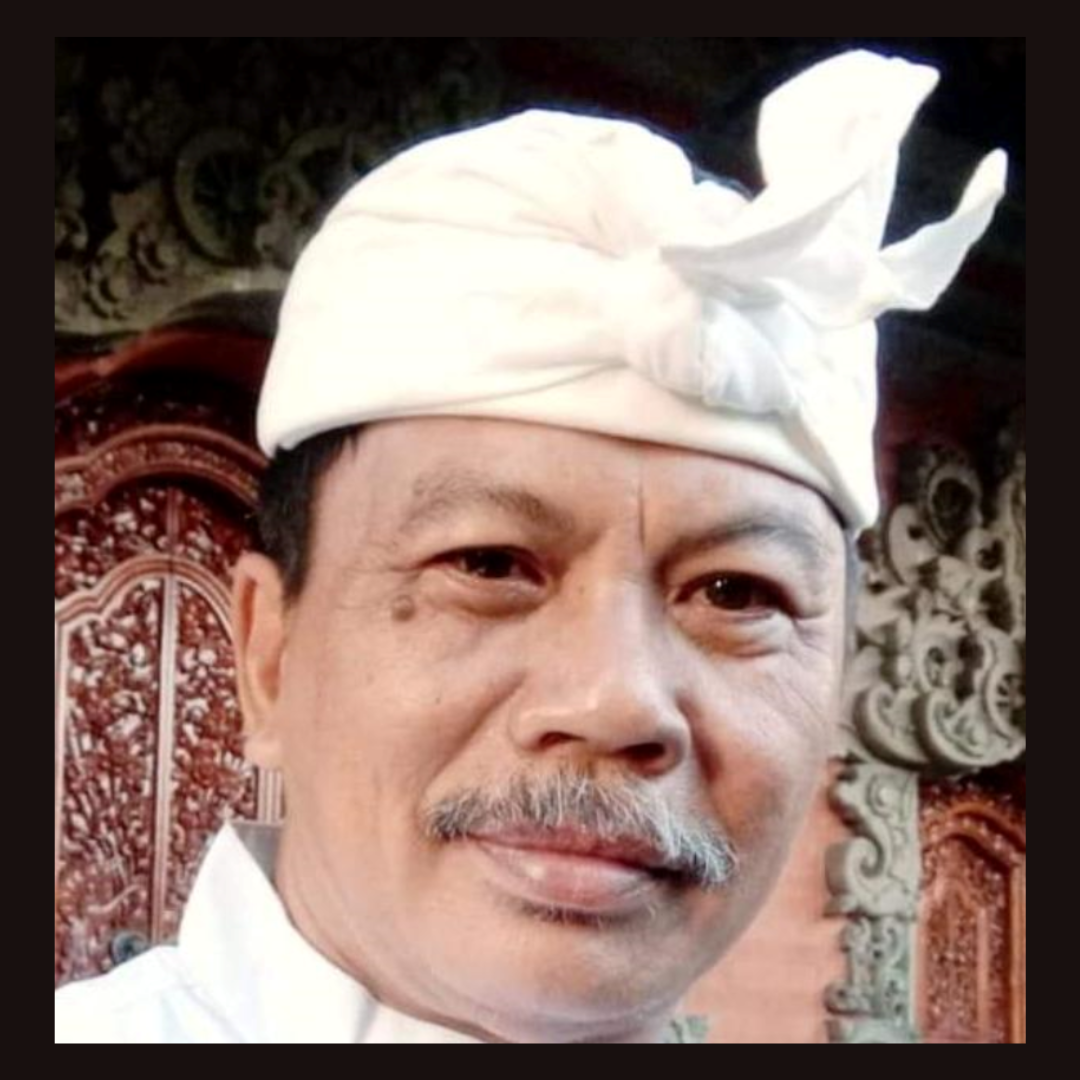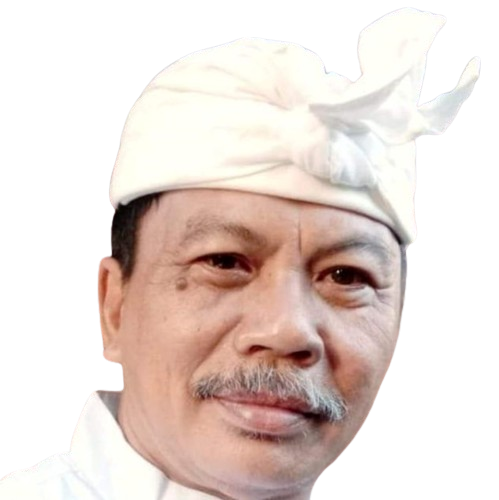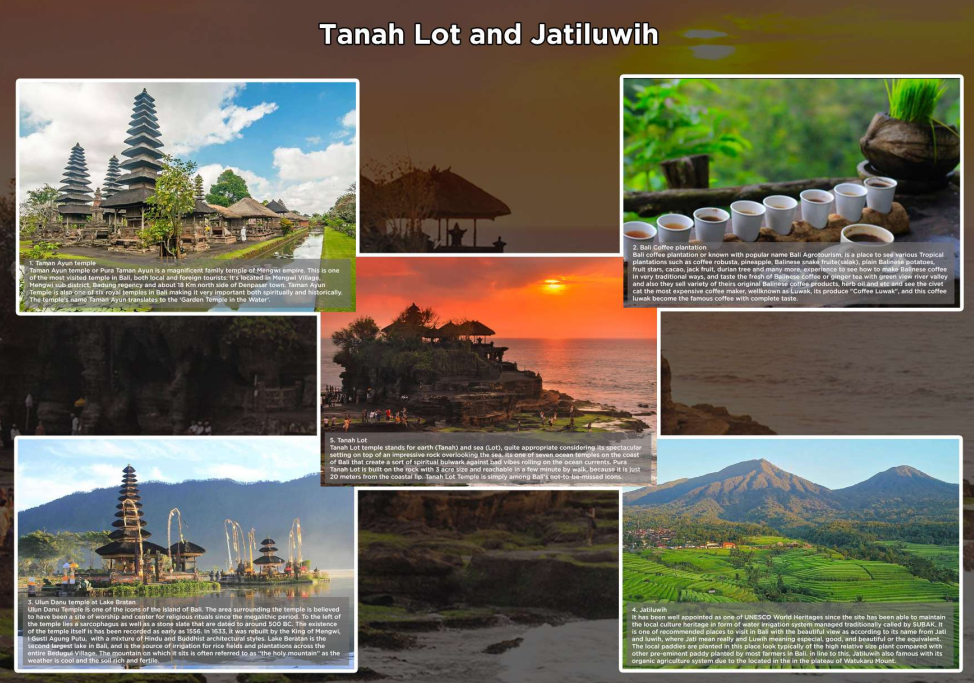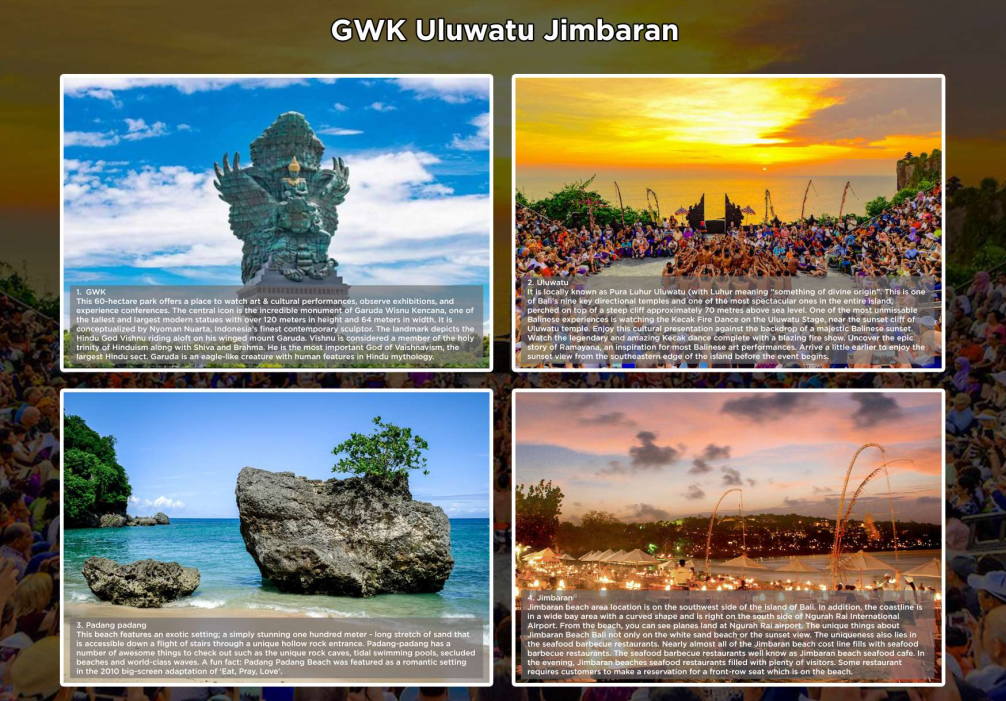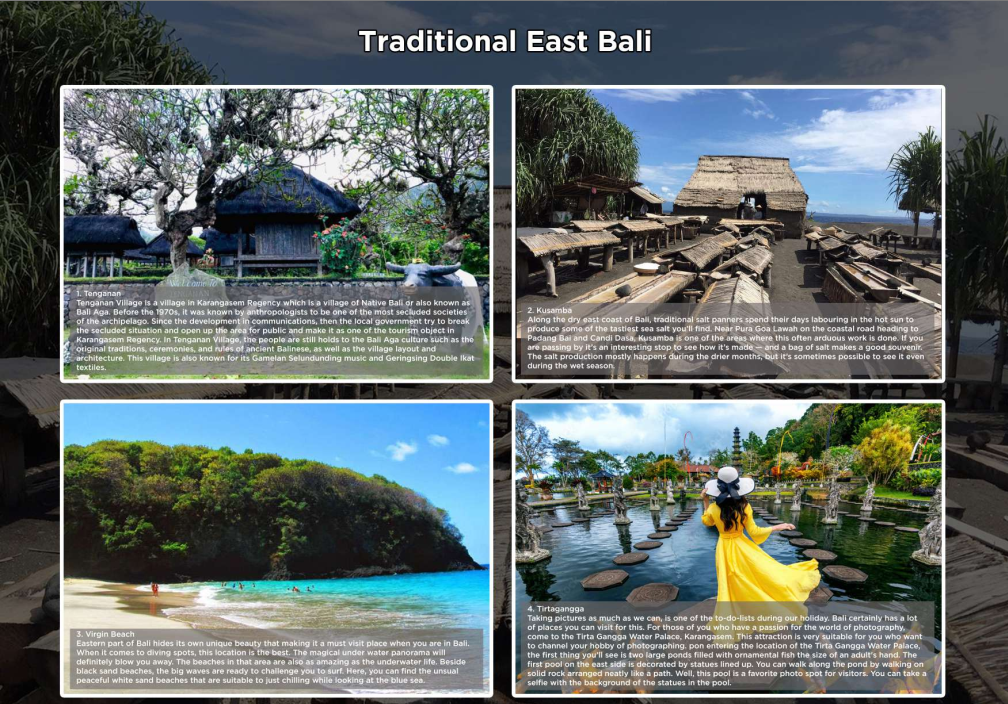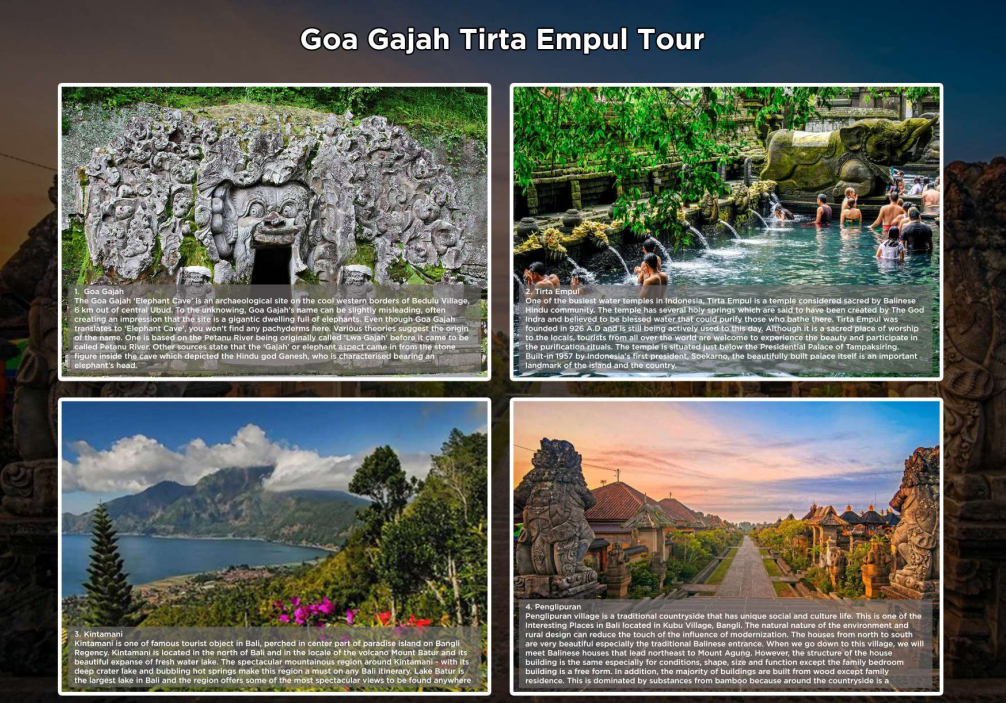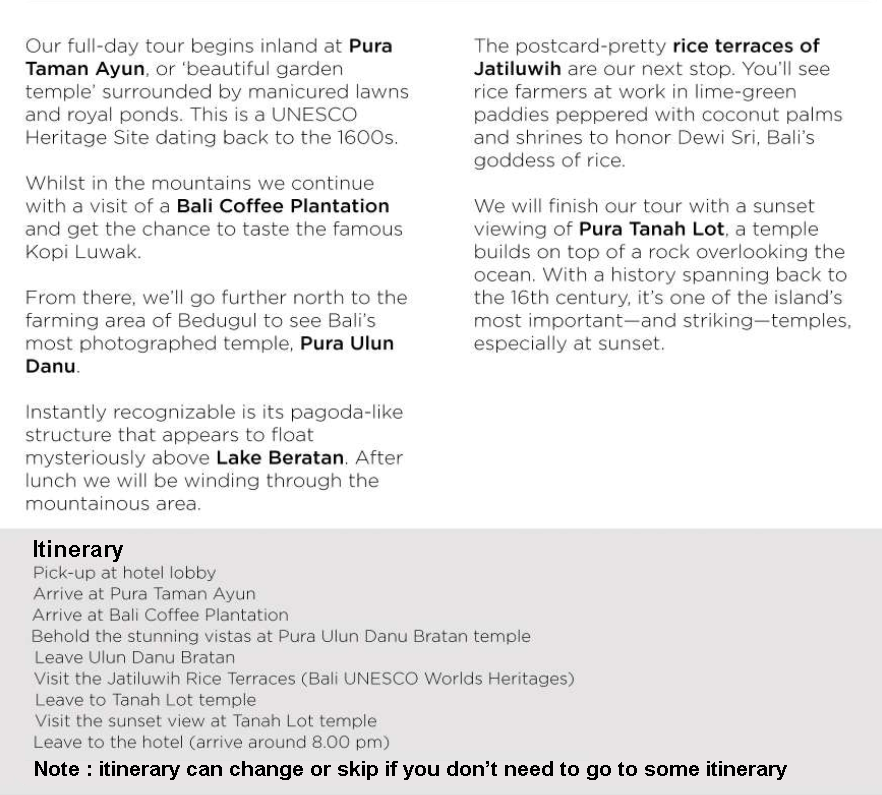
Tanah Lot
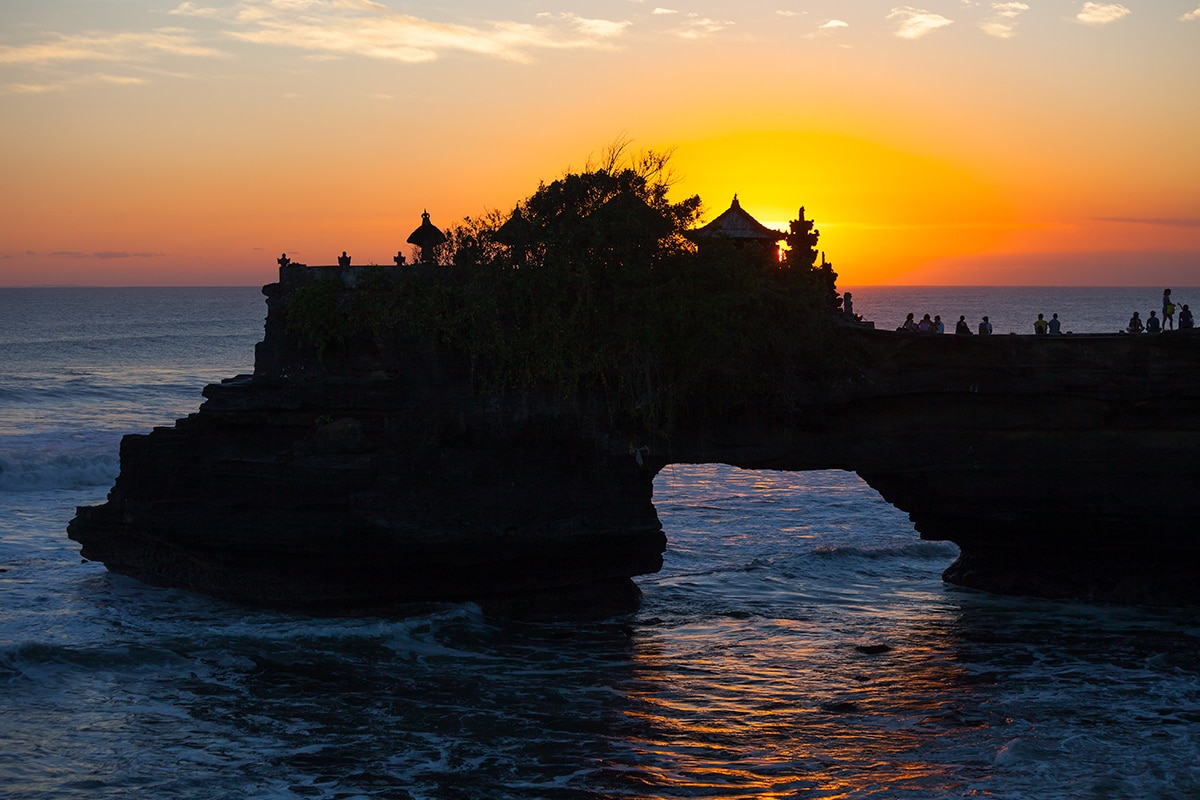
Magnificent Balinese Temple in the Open Ocean
To many people, Tanah Lot epitomizes the romantic island of Bali. Tanah Lot means Land in The Sea, a perfectly fit name for its unique offshore settings. The silhouette of Pura Tanah Lot is one of the most popular iconic features of Bali.
Imagine the image of a Balinese temple (pura) perched high on the rock, facing the wide open ocean. With the crashing waves below and the dramatic colors of the dusk sky as background, lit by the slowly disappearing sun. Tanah Lot is located in Tabanan, only around 30 km away from Denpasar. The temple is located some 300 meters offshore. The history of Tanah Lot temple was believed to date back to the 16th century, by Dang Hyang Nirartha, a respected religious figure in Bali.
Dang Hyang Nirartha was said to be the one who created a three-temple system in Balinese villages. Setting the site plan that the temple built in the northern area of the village would be for Brahma, middle area for Vishnu and the southern side for Shiva. While traveling along the southern coast of Bali, he saw the little rock-island and decided to spend the night. The rock was known as Gili Beo, which means a bird-shaped rock, located in Beraban village. He then felt an enlightenment, that this was a holy place to build a shrine. The leader of Beraban was angry and order people to banish Nirartha from Gili Beo.
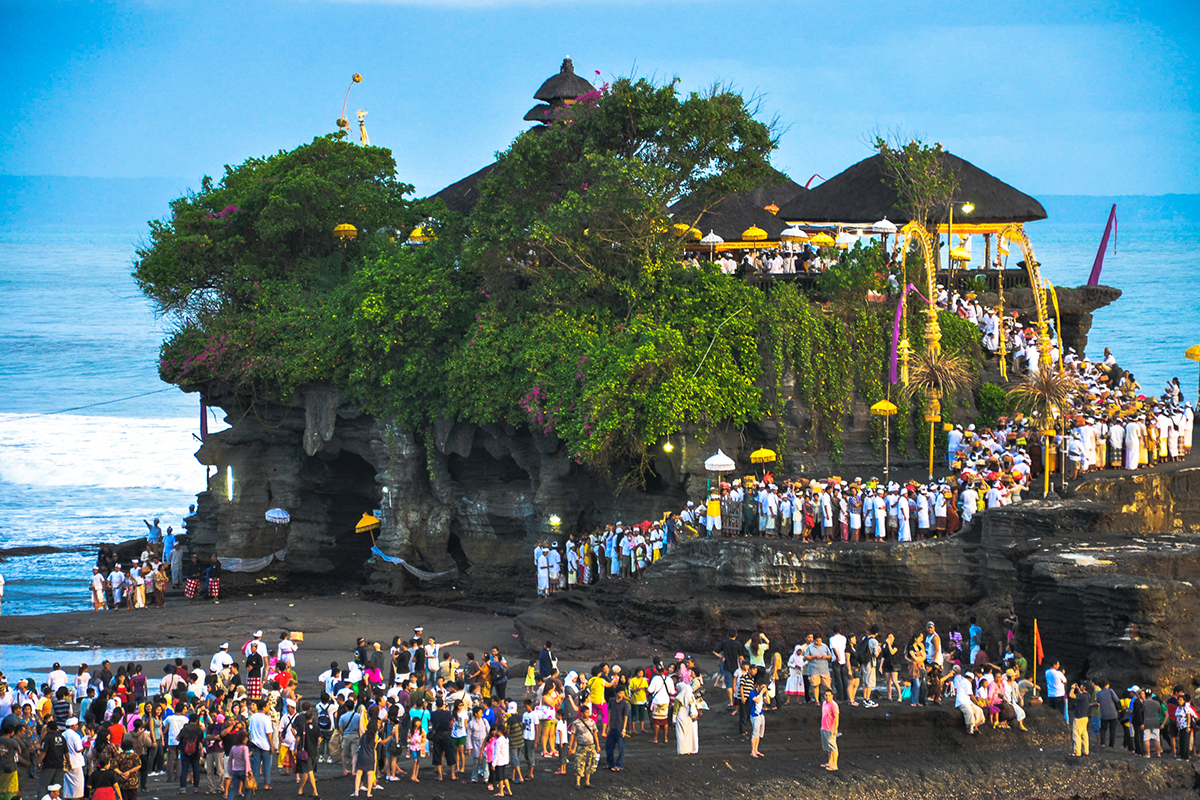
In Balinese mythology, Dang Hyang Nirartha was known as a man of mighty supernatural power. So he moves the whole rock island to the sea, builds a temple and named it Tanah Lot. The whole Beraban village were astounded and later join to follow he believes. Tanah Lot temple was built to worship Bhatara Segara, or the sea God. To protect the temple, with his mighty power, he created a poisonous snake from his sash. The sea snake is believed to be living at the base of this rocky island, to guard the temple from evil intruders.
Today, as one of the most photographed sea temple in Bali, you will find many art shops offering local handicrafts besides other signature local products at the entrance to get to Tanah Lot.
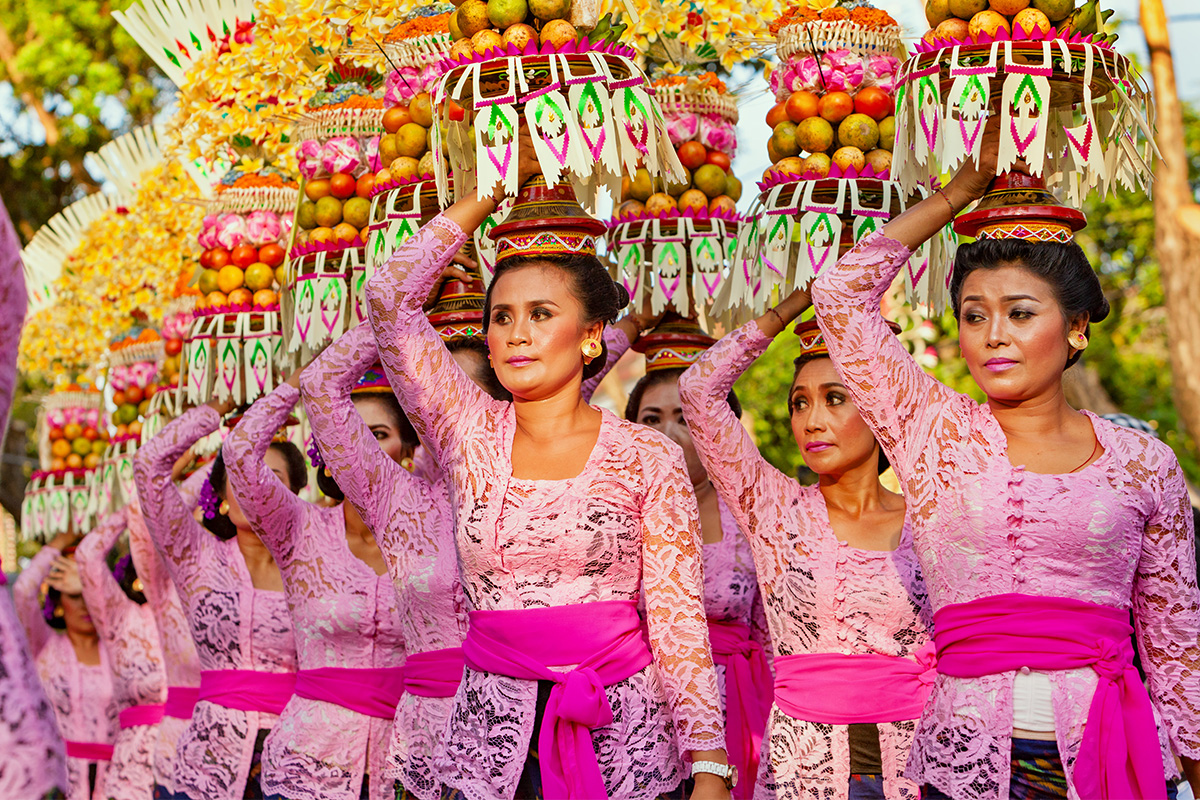
The best time to visit Tanah Lot is during Odalan, which is celebrated every 210 days. The rituals usually takes place near the Galungan and Kuningan festivities on the holy day known as Buddha Cemeng Langkir. On this day you will see rows of Balinese women gracefully carrying offerings on their head to pray at the temple of Tanah Lot. The tourist area of Tanah Lot near the rock is very well managed for visitors. It has a parking area, toilets, art shops, restaurants, hotel, open stage, tourist information center, security and safety services.
There are many restaurants here where you can enjoy a sumptuous breakfast or lunch, while enjoying the panorama. Experience the serenity of the tropical sun slowly disappearing beyond the horizon into the wide open ocean, an incredible sight to treasure all your life.
Get There
Tanah Lot is located around 30 km away from Ngurah Rai Airport in Denpasar. Coming from Denpasar on the main highway and arriving in the town of Kediri, you will certainly not miss the large sign at the main intersection announcing the southwest turn to Pura Tanah Lot. To reach the temple of Tanah Lot you will need to cross some dry land then climb a hill to reach the site of the temple.
Get Around
Inside the temple area, you can just walk around and explore its photogenic surroundings. Although famous for its sunset view, you may also want to try coming at really early in the morning, so that there will be less crowd and higher chance to have a serene image of the temple. There are also several temples that you can visit around Tanah Lot. They are Pura Pekendungan, Pura Batu Bolong, Pura Jero Kandang, Pura Enjung Galuh, and Pura Batu Mejan.
These temples have a variety of legends and myths surrounding their historical roots. When Nirartha left Beraban village, he bestows a special keris -a blade like a traditional weapon- to the Beraban leaders. The Ki Batu Gajah keris was said to possess the ability to repel plant diseases from crops. This keris was kept in Pura Pekendungan, before it is now safely stored in Puri Kediri. But on Odalan day, Ki Batu Gajah keris is always involved in the ceremonies.
Pura Batu Bolong is another extraordinary sea temples build upon a jutting rock cliff. Batu Bolong means “hollowed stone”, depicted from its obvious characteristic. It is said to be the twin of Tanah Lot, with many similar features between the two.
Located in Canggu, Batu Bolong sea temple is the cradle of the holy spring water. Many important Balinese rituals and ceremonies are held on this stunning location. Pura Jero Kandang in Tabanan is a temple devoted to seeking wellness and protection for livestock and agricultural crops. Pura Enjung Galuh is a temple renowned for a place to worship the Goddess Sri. Here, devotees pray for welfare and prosperity. Pura Batu Mejan is the location of Tirta Penglukatan, a holy spring believes to have to purify bliss against all negativity.
Jatiluwih
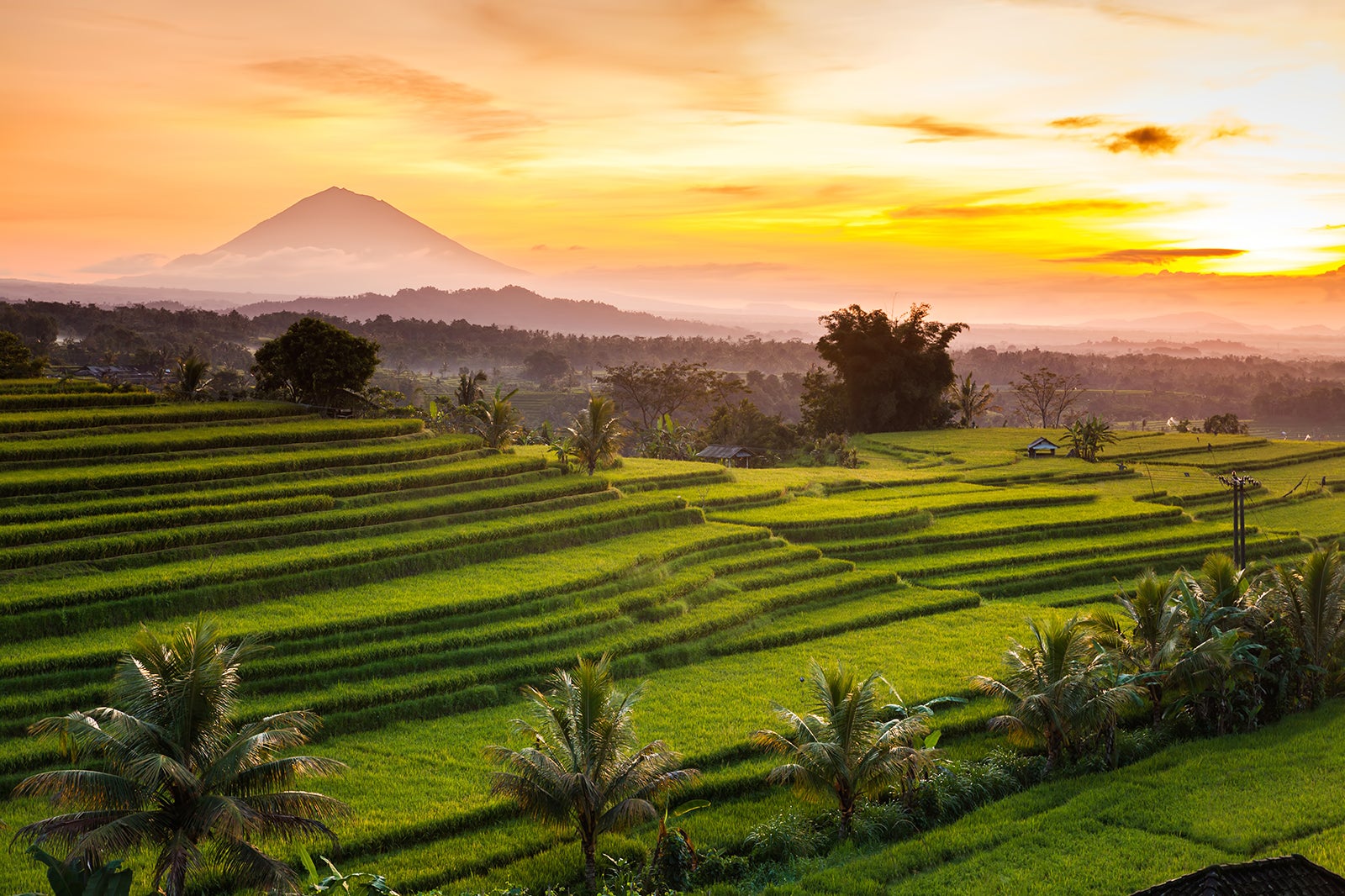
Jatiluwih – The stunning beauty of rice terraces
Jatiluwih area has always been known as one of the regions in Bali that produces great quality of rice. Located in the highlands (700 meters above the sea levels), and nearby the second tallest volcano in Bali, Mount Batukaru. It spans more than 53,000 hectares agriculture fields covered mostly with rice terraces. The area has hilly contours with fertile soils and offers an incredible scenery for photographs. Back in the day, the locals did not realize they have shaped nature into such a spectacular way that would be protected as a UNESCO Heritage Site. Today you’ll find Jatiluwih to be one of Bali’s must-see attractions, an iconic landmark that’s worth a visit for sure.
Jatiluwih – a mystical place
There are stories of Jatiluwih that are both historical and mythological, some are still told and to some extend believed today among the local community. One said folklore explains that Jatiluwih is derived from the word “jaton” and “luwih”, jaton meaning charm and luwih meaning good, so it can be interpreted Jatiluwih is a village that is filled with goodness, like a lucky charm. Another explanation for its name is that Jatiluwih was once a burial area of Jatayu (a mythology creature/ demi-god in the form of a Garuda bird). At that time, Jatayu was often also pronounced as Jatonayu, which somewhat sounds similar to Jatiluwih.
Because of its popularity in earlier centuries, there were many people with diverse backgrounds such as Brahmana, Ksatria, Wesia and Sudra visiting Jatiluwih from other areas of Tabanan. They also built some temples such as Pura Luhur Petali, Pura Luhur Bhujangga Waisnawa, Pura Rsi, Pura Taksu and other sacred places in the nearby area.
Visiting the Jatiluwih Traditional Village
Once Jatiluwih began to become more recognized by visitors from abroad, the local community wanted to make the area more accessible to visitors while also making sure that it is protected from any potential negative effects of tourism. Jatiluwih village is now one of the traditional villages showcased as a tourist attraction and is overseen by the government.
Visitors can learn about the concept of agricultural tourism, rice terraces, the subak system, and join various activities of farmers in Jatiluwih. You can volunteer to be a farmer for a day by doing; hoeing, Nampadin (cleaning procession for rice field), Ngelampit (plowing rice field), Melasah (leveling the soil of the rice field), Nandur (planting the rice), etc.
Other activities include trekking, hiking and cycling through the rice fields when you visit the village, as it is a beautiful and refreshing experience. There are some cosy, cafes, warungs, and restaurants with signature dishes that is sourced using fresh produce grown only in Jatiluwih.
When best to visit Jatiluwih?
If you are planning to visit Jatiluwih, it is recommended to arrive in the morning around 8:00 am until 10:00 am. Usually, this area will become very busy during lunch hours. During afternoon, the rice terraces would often turn misty with low hanging clouds that hinder the spectacular view, but it has its own charm. Due to the high level of altitude, it can indeed rain in this area often. Visitors are advised to bring raincoats or umbrellas when visiting Jatiluwih.
Visit between February to April, as in these months the rice stalks are starting to grow and you will be able to witness the green-yellow carpets of rice terraces. During June – July (called Sasih Sada), you will be able to see farmers harvesting their crops on site.
In Bali, the frequency of rice harvests depends on the rice planting cycle and the type of rice being cultivated. The two main types of rice grown in Bali are “wet rice” and “dry rice,” each with its own planting and harvesting seasons.
Wet Rice Cultivation:
- Wet rice, also known as “sawah,” is the most common type of rice cultivation in Bali. It requires irrigation and is grown in flooded fields.
- Planting Season: Wet rice is typically planted during the rainy season, which begins around November and lasts until March or April.
- Harvesting Season: The harvest season for wet rice usually takes place about three to four months after planting, during the dry season. Therefore, wet rice is typically harvested from February to June.
Dry Rice Cultivation:
- Dry rice, also known as “tegalan,” is a type of rice cultivation that relies on rainwater and does not require flooding the fields.
- Planting Season: Dry rice is usually planted during the dry season, from May to October, when there is no need for extensive irrigation.
- Harvesting Season: Dry rice is typically harvested about three to four months after planting, during the rainy season. Therefore, the harvest season for dry rice falls between October and January.
It’s important to note that these time frames are approximate and may vary slightly depending on factors like weather conditions and local agricultural practices. Additionally, some regions in Bali might have different planting and harvesting schedules based on microclimates and local customs. Rice harvesting is a significant event in Bali’s agricultural calendar and often involves communal efforts where neighbors come together to help each other with the labor-intensive process.
Rice Terraces in Bali
Terracing is one of the methods in agriculture management, that is created to make agriculture possible on lands that have a steep contour, such as the highlands and mountain slopes. Bali’s known for the Subak irrigation system that is considered sacred and culturally important and has been developed all over the island since the 11th century.
The system is developed based on the Hindu religion’s beliefs of being in harmony with nature in order to yield optimal results upon harvesting. This is manifested due to the Tri Hita Karana philosophy, a philosophy of maintaining balance between man, nature, and the Creator. Since 2012, Subak has been listed as one of the UNESCO cultural world heritage sites.
